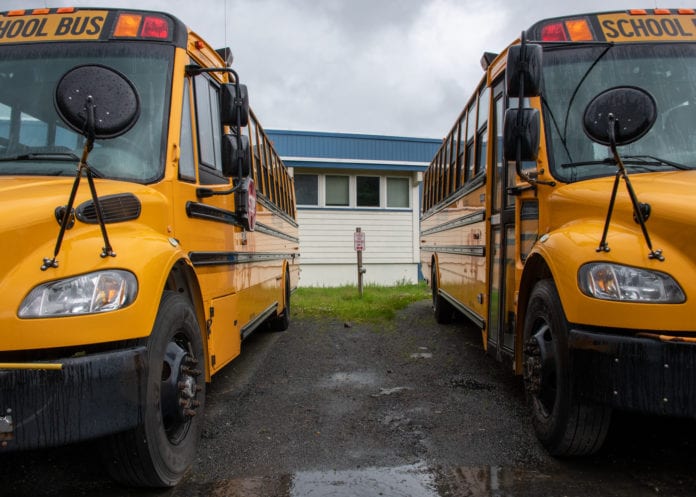
Cordova Jr./Sr. High School will go to online-only learning through Feb. 4, due in an increasing number of pandemic related student and staff absences. Mt. Eccles Elementary School will remain open for teaching in the classrooms, Superintendent Alex Russin announced Monday, Jan. 24.
All extra-curricular activities at CHS were also suspended Jan. 24 through Feb. 4, he said.
Mt. Eccles Elementary students and teachers have been much less severely impacted by the pandemic, he said.
Parents were urged to remain vigilant in monitoring their children for any symptoms and to contact their healthcare provider with any questions.
CHS was ordered closed Tuesday, Jan. 25, to allow staff to prepare an online format for teaching through Feb. 4. The school district will continue to monitor the situation and make adjustments as necessary, Russin said.
The announcement came in the wake of the latest statewide pandemic update from the Alaska Department of Health and Social Services of 5,759 more people testing positive for COVID-19 in Alaska from Jan. 21 through Jan. 23, plus 21 more deaths. On Jan. 21, DHSS reported another 6,532 people were confirmed to have COVID-19. That brought the five-day total to 12,291 new cases, including 13 in Cordova and 28 in the Copper River Census Area.
During a weekly teleconference with news media on Thursday, Jan. 20, Dr. Anne Zink, the state’s chief medical officer, said that Alaska is now in a new phase of the pandemic.
“We will see a fast hike in rates, but not the same rate of hospitalizations,” she said. “We also have more protection now than we have had before and more treatment and testing functions than ever before.”
Zink also repeated her advice for those who think they have COVID-19 symptoms to get tested about five days after they were exposed to someone who did test positive, or if they are traveling or have been indoors with unmasked people.
Nationally, health care officials are saying there are clear signs of optimism for an end of the omicron variant surge, with experts saying the most serious threat may be over the next month and crest by the end of February. Sixteen states, including Alaska, have seen omicron variant spikes in the past week.
Since the pandemic spread to Alaska in March 2020 there have been some 3,000 resident hospitalizations and 1,039 Alaska resident deaths. With test kits now available for personal use, DHSS is no longer providing updates on the number of tests given overall, but notes that the statewide alert level for the pandemic virus remains at high.
Dr. Hannah Sanders, chief executive officer of the Cordova Community Medical Center, said that as the pandemic continues to impact the community “we feel it’s time that prevention and treatment of this illness be integrated into our everyday medical practice.”
Since the onset of the pandemic, a pretty large team of medical providers have come together to procure equipment and supplies to protect staff and deploy the vaccine, Sanders said. Thanks to the cooperation of all groups in the area, including schools and villages, they have worked very efficiently together, she said.
In the early weeks of the pandemic and beyond one of the challenges has been staff having to quarantine, due to exposure and/or tests that came back positive, “but overall, we have been able to maintain our operations,” she said. “We had a coordinated response. Our staff did an excellent job. We had the equipment we needed. The team is feeling confident in its response. We are now integrating management of the pandemic into the normal daily medical practice.”
Tamara Russin, clinic manager and director of Ancillary Services at CCMC, oversaw set up of testing and securing vaccines for the hospital.
“Testing goes on every day; it’s part of everyone’s everyday life,” she said. “We are able to provide everyone with testing. We feel like we are doing something proactive, like we are operating for the return of life as we would like it to be. I’m hoping that we will get past the pandemic.”
“The big impact when it started was that we all had fulltime jobs to begin with, and then COVID became a priority,” said Vivian Knop, materials manager/pharmacy technician at CCMC. “We all had to find a new way to balance.
“Fortunately because we are remote, I have a lot of stock on hand,” she said. “However, we did run into some challenges with masks. There was coordination with the hospital and the Ilanka Clinic for our supplies, to be sure we could accommodate the needs for health care.”
At first, with no test kits available, health care workers in Cordova swabbed those needing tests and sent the results in to determine who had the virus and who did not.
“Now we have machines and equipment to run the tests (here),” Knop said. “A lot of people did a lot of work. We had a lot of people spending a lot of hours figuring out the process. We did pretty good.”














